LEON COUNTY JUDGE RULES BULLET TRAIN COMPANY CAN’T USE EMINENT DOMAIN ON ACCOUNT OF IT’S NOT REALLY A ‘RAILROAD’ YET 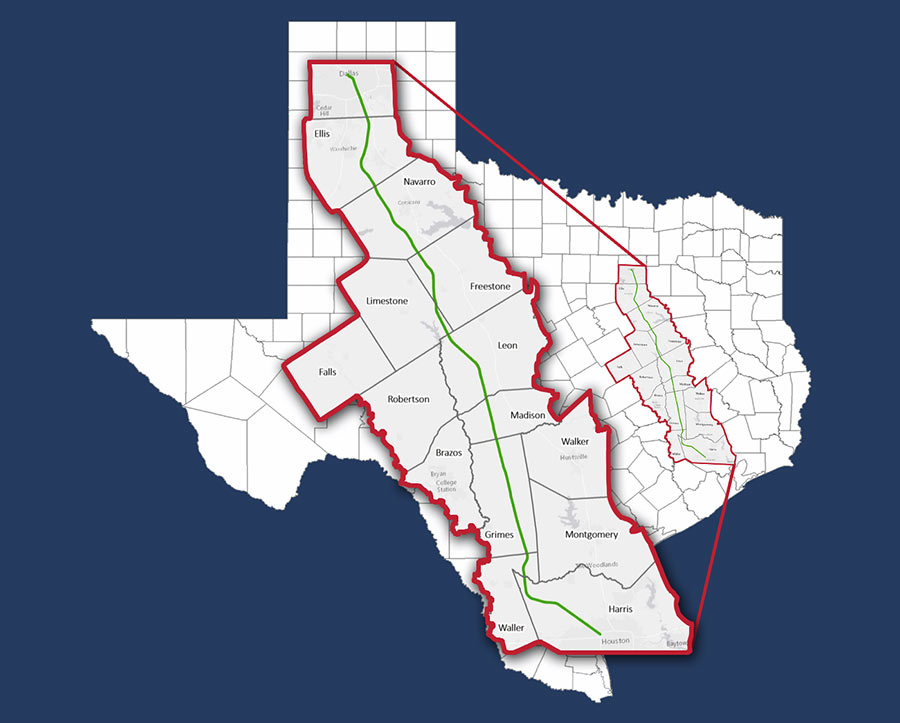 On Friday, the judge for Texas’s 87th District Court declared that Texas Central, the company planning a high-speed rail line between Houston and Dallas, cannot use eminent domain to snatch up land within Leon, Freestone, or Limestone counties — 3 of the 10 counties that the train’s proposed 240-mile route is set to traverse. Texas law does allow “railroads” to use eminent domain in seizing land for projects, it’s just that Texas Central doesn’t actually count as a one in the court’s view because it hasn’t actually laid any track yet and doesn’t currently operate any trains. “Texas Central is appealing the Leon County judge’s decision,” the company tells the Chronicle‘s Dug Begley, “and meanwhile, it is moving forward on all aspects of the train project.” [Houston Chronicle; previously on Swamplot] Map of proposed bullet train route: Texas Central
On Friday, the judge for Texas’s 87th District Court declared that Texas Central, the company planning a high-speed rail line between Houston and Dallas, cannot use eminent domain to snatch up land within Leon, Freestone, or Limestone counties — 3 of the 10 counties that the train’s proposed 240-mile route is set to traverse. Texas law does allow “railroads” to use eminent domain in seizing land for projects, it’s just that Texas Central doesn’t actually count as a one in the court’s view because it hasn’t actually laid any track yet and doesn’t currently operate any trains. “Texas Central is appealing the Leon County judge’s decision,” the company tells the Chronicle‘s Dug Begley, “and meanwhile, it is moving forward on all aspects of the train project.” [Houston Chronicle; previously on Swamplot] Map of proposed bullet train route: Texas Central
Transportation
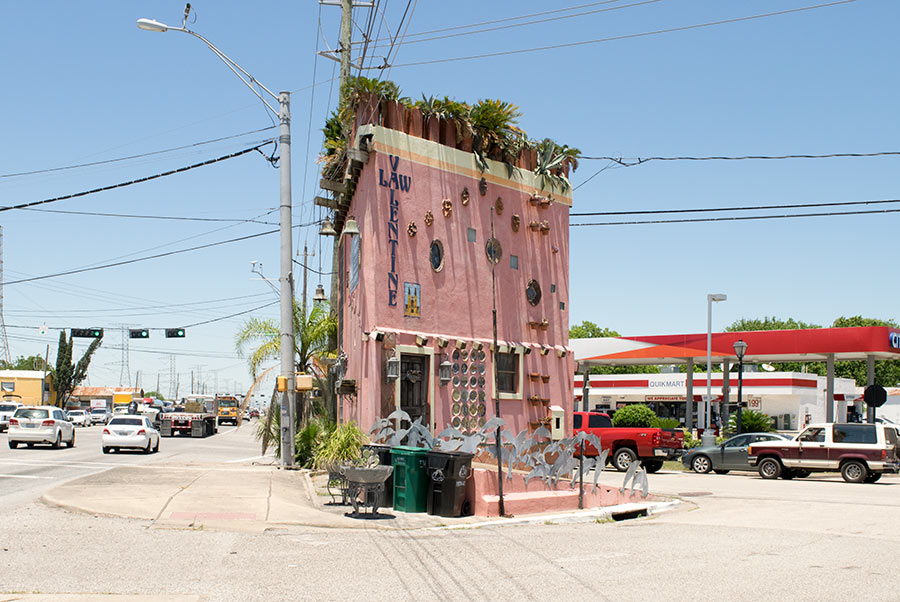
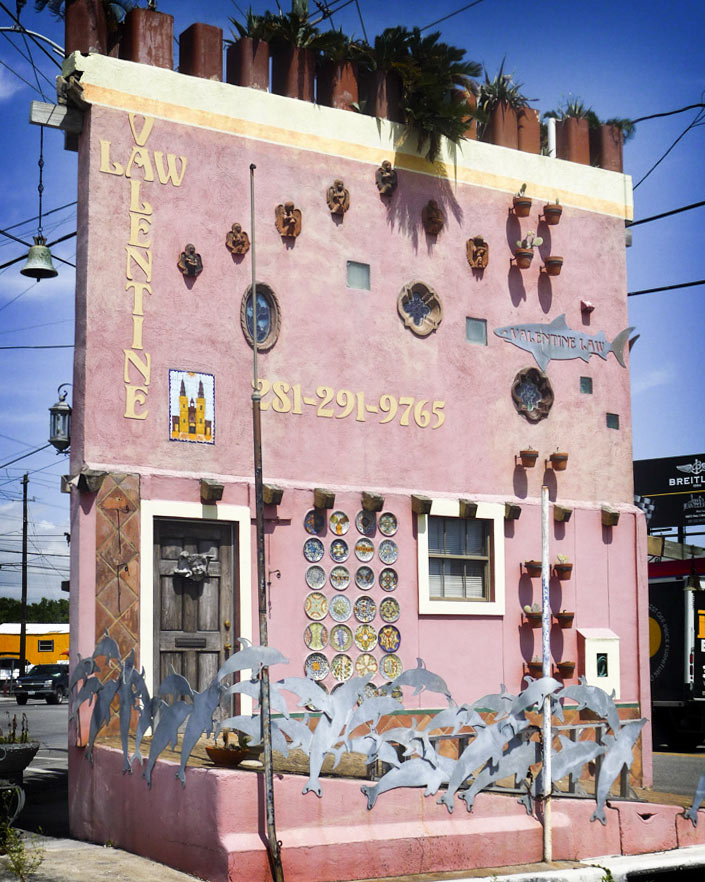
The 660-sq.-ft. law office marooned on a traffic island in Seabrook for 86 years might finally get ousted from its spot in local what-is-that-thing lore when TxDOT’s planned road widening project gets underway along a 3-mile stretch of Hwy. 146. Attorney Michael Valentine bought the building on the corner of Bayport Blvd. and 2nd St. in 1989 and did it up with the leafy haircut and shark dolphin-themed metal edging. (Bayport Blvd. is the segment of 146 that runs through Seabrook — shown to the left of building in the photo at top.) In its past lives, the 2-story wedge at 1210 Bayport had been at various points an ice house and a bait shop.
Documents filed with Harris County Clerk show that TxDOT agreed to snatch the building from Valentine for a sum of $114,356 last October after filing an eminent domain proceeding against the entity he uses to administer the property. At least 9 other businesses along Bayport, including Ryan’s Cleaners, Tookie’s Burgers, and Laredo’s Tex-Mex Cafe have already closed or relocated ahead of the roadwork that plans to turn 146 between Red Bluff Rd. and Clear Creek — currently 4 lanes — into 12.
COMMENT OF THE DAY: LET THE COLLEGE STATION LAND RUSH BEGIN! 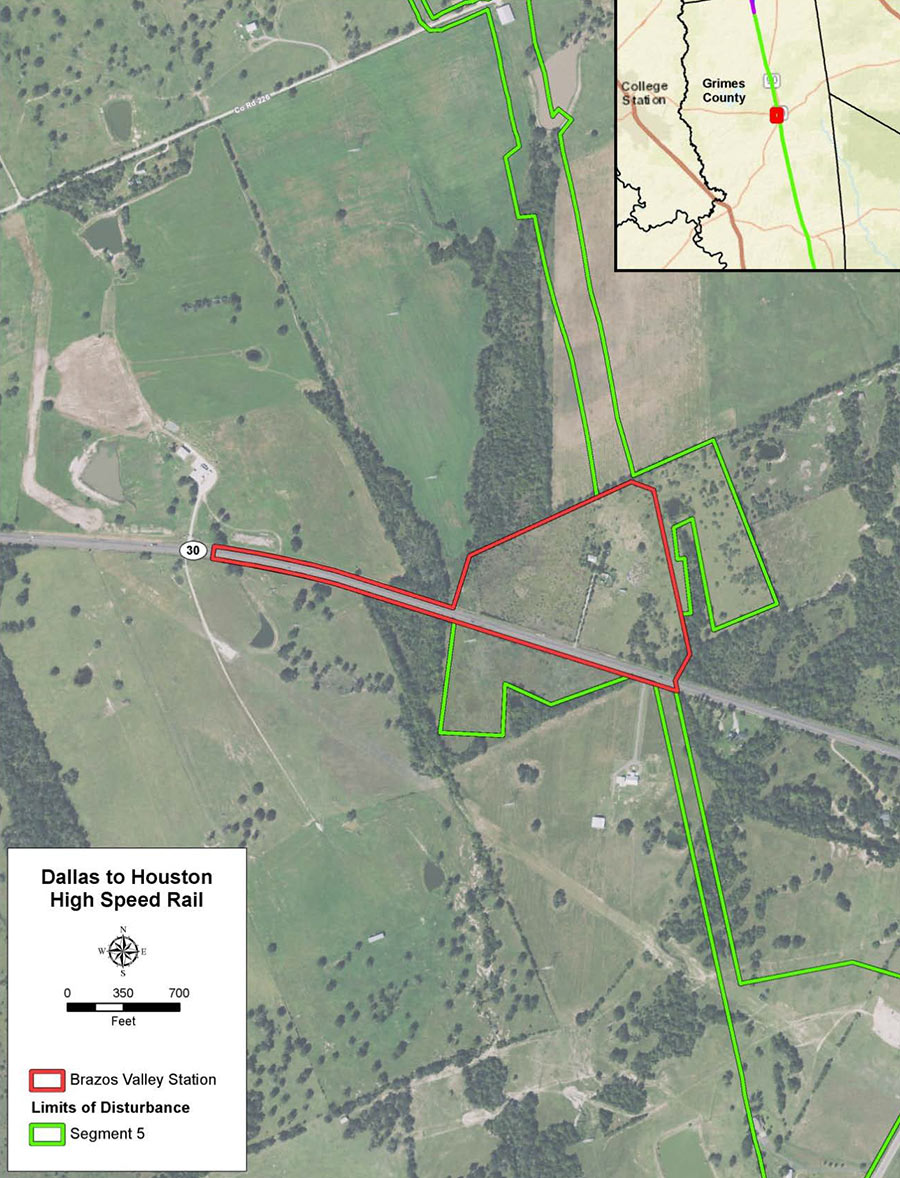 “The station in Roans Prairie is a developer’s dream: high-speed rail, new I-14 interstate, and miles and miles of undeveloped land. The master-planned communities will start popping up in no time. Work in the city (Houston or Dallas) and live out in the country on your acreage homestead. Just wait, the Bryan-College Station-Huntsville MSA will see the fastest population growth in the entire nation for years and years to come.” [Thomas, commenting on Proposed High-Speed Rail Line’s Bryan—College Station Station Would Be 27 Miles East of Texas A&M] Map of proposed Brazos Valley Station: Federal Railroad Administration
“The station in Roans Prairie is a developer’s dream: high-speed rail, new I-14 interstate, and miles and miles of undeveloped land. The master-planned communities will start popping up in no time. Work in the city (Houston or Dallas) and live out in the country on your acreage homestead. Just wait, the Bryan-College Station-Huntsville MSA will see the fastest population growth in the entire nation for years and years to come.” [Thomas, commenting on Proposed High-Speed Rail Line’s Bryan—College Station Station Would Be 27 Miles East of Texas A&M] Map of proposed Brazos Valley Station: Federal Railroad Administration

The only planned stop between Houston and Dallas on the proposed high-speed rail line shows up 27 miles east of College Station in a new report from the Federal Rail Road Administration. The map at top shows a rough outline of the Brazos Valley Station along Highway 30, as well as its surroundings in Roans Prairie, the small town that would host it.
Roans Prairie’s main drag is further east, off the map at the junction of highways 30 and 90. The town is currently home to a Valero gas station, Family Dollar store, U-Haul dealer, and Mobile Homes for Less.
- Draft Environmental Impact Statement [Federal Railroad Administration via Christof Spieler]
- Previously on Swamplot:Â The 3 Finalists for Houston’s High-Speed Rail Station: Northwest Mall, Northwest Transit Center, Hempstead Rd. Industrial;Â The Ride to the Bullet Train at Northwest Mall;Â Houston-to-Dallas Bullet Train Putting the Brakes on All Those Lawsuits
Image: Federal Railroad Administration
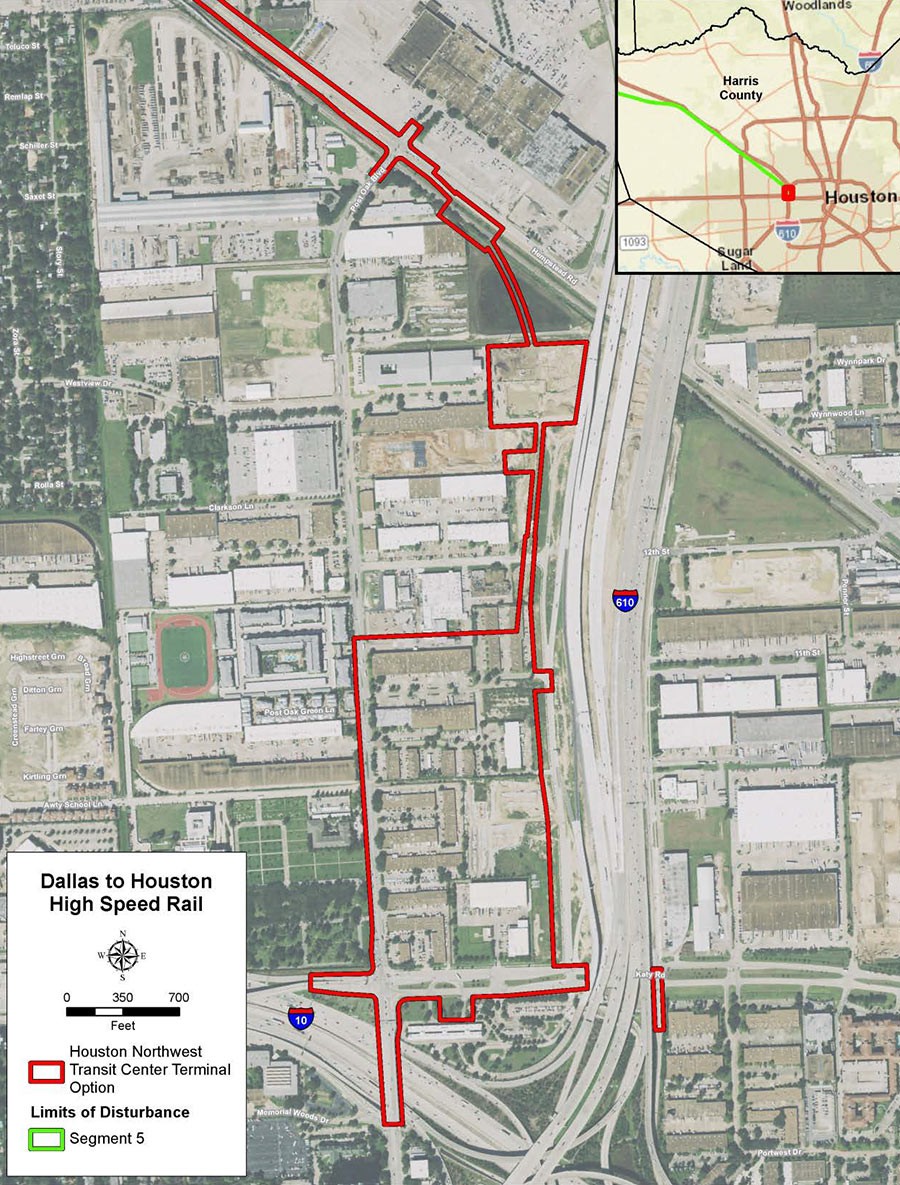
One of these 3 spots revealed in a report from the Federal Railroad Administration will be the planned site for the Houston-Dallas high-speed rail line’s Houston terminal. All 3 are near the intersection of the 610 Loop and the BNSF rail tracks that run parallel to Hempstead Rd. just south of 290.
In the map at top, the station takes the land directly north of the Northwest Transit Center, where an industrial complex home to Icon Electric, Engineering Consulting Services, and others exists now. Hempstead Rd. is shown fronting Northwest Mall at the top of the plan.
Another proposal puts the station in the spot where the mall is now:
THE WOODLANDS BEATS HOUSTON TO ITS DOCKLESS BIKESHARING FUTURE  While Houston’s city council debates proposed new regulations that might allow as many as 6 competing companies to let loose as many as 3,500 new leave-’em-anywhere shared bicycles each across the city over the course of a year, The Woodlands has decided to go ahead with its own smaller kiosk-free program — with a single vendor. Mobike, a 2-year-old Chinese company now ranked as the largest bike-sharing organization in the world, will begin unleashing 50 to 100 bicycles, mostly intended to be used around The Woodlands Town Center. The company has operated in Washington DC since September. The Woodlands Township entered into the agreement with Mobike after a pilot program approved in October with Houston docked-bike vendor B-Cycle stalled. [Houston Chronicle] Photo: Mobike
While Houston’s city council debates proposed new regulations that might allow as many as 6 competing companies to let loose as many as 3,500 new leave-’em-anywhere shared bicycles each across the city over the course of a year, The Woodlands has decided to go ahead with its own smaller kiosk-free program — with a single vendor. Mobike, a 2-year-old Chinese company now ranked as the largest bike-sharing organization in the world, will begin unleashing 50 to 100 bicycles, mostly intended to be used around The Woodlands Town Center. The company has operated in Washington DC since September. The Woodlands Township entered into the agreement with Mobike after a pilot program approved in October with Houston docked-bike vendor B-Cycle stalled. [Houston Chronicle] Photo: Mobike
WAS IT A GOOD IDEA TO DERAIL I-10? 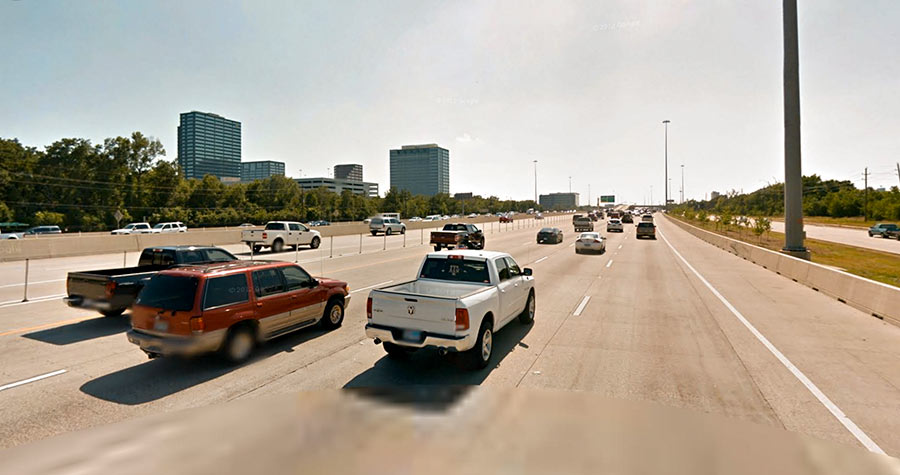 Earlier this week Harris County Judge Ed Emmett appeared to pass judgment on one aspect of the Katy Fwy. widening completed almost a decade ago: “We cannot go back in time and undo some poor decisions, but we can learn from those decisions. One of the most glaring mistakes was the failure to convert the abandoned Katy rail line to commuter rail. Think about it, we had a straight shot from Katy all the way into Downtown.†But ripping up the tracks did not render a future rail line along the path of I-10 completely impossible, notes Dug Begley: “Though the rail line was removed, Metropolitan Transit Authority paid for overpasses along I-10 to be built to rail standards, meaning that if the region ever wanted to use the freeway for light rail, that is possible. Larger, commuter, trains, however would not be able to operate in the freeway.” [Houston Chronicle] Photo: cemaxx (license)
Earlier this week Harris County Judge Ed Emmett appeared to pass judgment on one aspect of the Katy Fwy. widening completed almost a decade ago: “We cannot go back in time and undo some poor decisions, but we can learn from those decisions. One of the most glaring mistakes was the failure to convert the abandoned Katy rail line to commuter rail. Think about it, we had a straight shot from Katy all the way into Downtown.†But ripping up the tracks did not render a future rail line along the path of I-10 completely impossible, notes Dug Begley: “Though the rail line was removed, Metropolitan Transit Authority paid for overpasses along I-10 to be built to rail standards, meaning that if the region ever wanted to use the freeway for light rail, that is possible. Larger, commuter, trains, however would not be able to operate in the freeway.” [Houston Chronicle] Photo: cemaxx (license)
COMMENT OF THE DAY: DON’T TALK TO ME ABOUT THE WEATHER 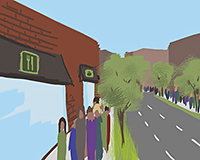 “I lived in Washington, DC for 8 years and the typical Washington summer day is every bit as miserable as a Houston summer day. (There are somewhat fewer of them, of course.) And all summer, the streets were crowded with people walking. In the dead of winter, when it was 20 degrees out, the streets were full of people walking. The difference is that the city was built for walking; sidewalks rarely vanished mid block. Pedestrian crossings weren’t a mile apart. There were relatively few city streets eight lanes wide to get across.
Obviously the central city density was a big part of that, but funny thing: people seem to actually like walking. Part of that time I lived in Arlington, VA, which is about like the Heights in density, and I thought nothing of walking 15 minutes up the street to the Metro station or the main boulevard where the shops and cafes and whatnot were. I also would regularly visit friends in Takoma Park, MD, another surburban-ish area, and . . . people walked.
When I was in college in upstate NY, people walked (most students didn’t have cars on campus, because why would you have a car on campus). People walked 20 minutes downtown on subzero nights to go drinking. People trudged up the giant hill to campus in snow and wind. They could wait for the campus shuttle bus a lot of the time . . . but mostly they didn’t. They walked.
There are very real reasons that people don’t walk as much in Houston, but the weather ain’t one of them.” [John (another one), commenting on Comment of the Day: Walking Is Not Native to Houston] Illustration: Lulu
“I lived in Washington, DC for 8 years and the typical Washington summer day is every bit as miserable as a Houston summer day. (There are somewhat fewer of them, of course.) And all summer, the streets were crowded with people walking. In the dead of winter, when it was 20 degrees out, the streets were full of people walking. The difference is that the city was built for walking; sidewalks rarely vanished mid block. Pedestrian crossings weren’t a mile apart. There were relatively few city streets eight lanes wide to get across.
Obviously the central city density was a big part of that, but funny thing: people seem to actually like walking. Part of that time I lived in Arlington, VA, which is about like the Heights in density, and I thought nothing of walking 15 minutes up the street to the Metro station or the main boulevard where the shops and cafes and whatnot were. I also would regularly visit friends in Takoma Park, MD, another surburban-ish area, and . . . people walked.
When I was in college in upstate NY, people walked (most students didn’t have cars on campus, because why would you have a car on campus). People walked 20 minutes downtown on subzero nights to go drinking. People trudged up the giant hill to campus in snow and wind. They could wait for the campus shuttle bus a lot of the time . . . but mostly they didn’t. They walked.
There are very real reasons that people don’t walk as much in Houston, but the weather ain’t one of them.” [John (another one), commenting on Comment of the Day: Walking Is Not Native to Houston] Illustration: Lulu
COMMENT OF THE DAY: WALKING IS NOT NATIVE TO HOUSTON  “. . . I do think Houstonians tend to really regard walkers as oddities of nature.
Our climate doesn’t really foster a natural desire to walk outside so it is a strange sight to see someone actually — outside. Walking. As a native Houstonian, it has taken me decades to realize that walking along a bayou trail — and using relevant sidewalks to get to/from it — is actually quite nice.
That being said, I’m more mindful of fellow pedestrians when I’m in my car. I yield for them not only out of lawful duty, general Southern courtesy, but also as a slight ‘Atta boy!’ for them actually walking.” [Wolf Brand Chili, commenting on Comment of the Day: Unlearning That Nasty Stopping for Pedestrians Habit] Illustration: Lulu
“. . . I do think Houstonians tend to really regard walkers as oddities of nature.
Our climate doesn’t really foster a natural desire to walk outside so it is a strange sight to see someone actually — outside. Walking. As a native Houstonian, it has taken me decades to realize that walking along a bayou trail — and using relevant sidewalks to get to/from it — is actually quite nice.
That being said, I’m more mindful of fellow pedestrians when I’m in my car. I yield for them not only out of lawful duty, general Southern courtesy, but also as a slight ‘Atta boy!’ for them actually walking.” [Wolf Brand Chili, commenting on Comment of the Day: Unlearning That Nasty Stopping for Pedestrians Habit] Illustration: Lulu
THE RIDE TO THE BULLET TRAIN AT NORTHWEST MALL 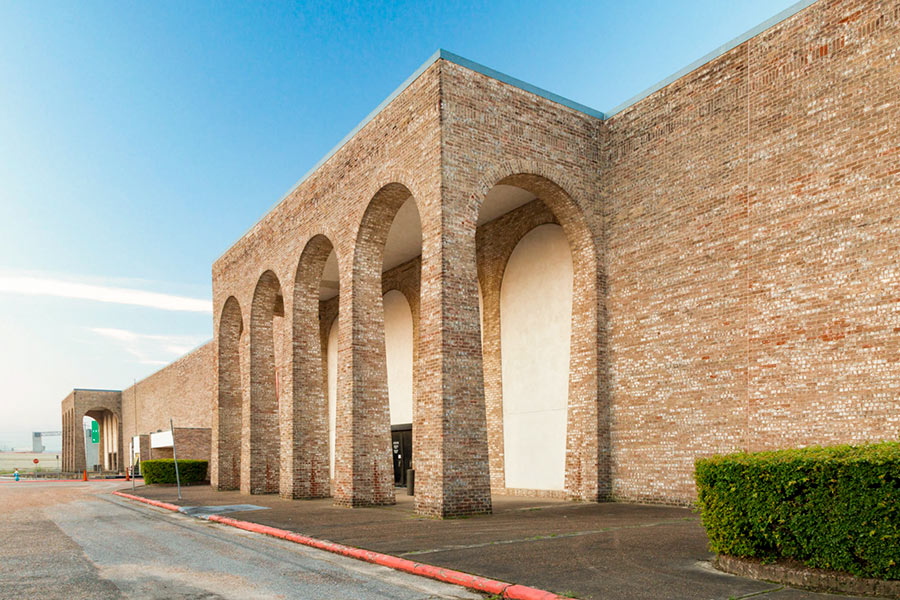 One piece of the agreement announced by Mayor Turner this morning with Texas Central Partners, the company behind a planned bullet train between here and Dallas: a promise that the city and the company will work together on transit options to and from the train’s Houston station. “In the memorandum,” Dug Begley reports, “Texas Central notes the likely end of their Houston-to-Dallas line will be south of U.S. 290, west of Loop 610 and north of Interstate 10. The exact site has been long suspected as the current location of Northwest Mall.” All but a handful of stores inside the mall shut down earlier this year. [Houston Chronicle ($); previously on Swamplot] Photo of Northwest Mall: Levcor
One piece of the agreement announced by Mayor Turner this morning with Texas Central Partners, the company behind a planned bullet train between here and Dallas: a promise that the city and the company will work together on transit options to and from the train’s Houston station. “In the memorandum,” Dug Begley reports, “Texas Central notes the likely end of their Houston-to-Dallas line will be south of U.S. 290, west of Loop 610 and north of Interstate 10. The exact site has been long suspected as the current location of Northwest Mall.” All but a handful of stores inside the mall shut down earlier this year. [Houston Chronicle ($); previously on Swamplot] Photo of Northwest Mall: Levcor
WHAT’S BLOCKING THE BRAYS BAYOU TRAIL 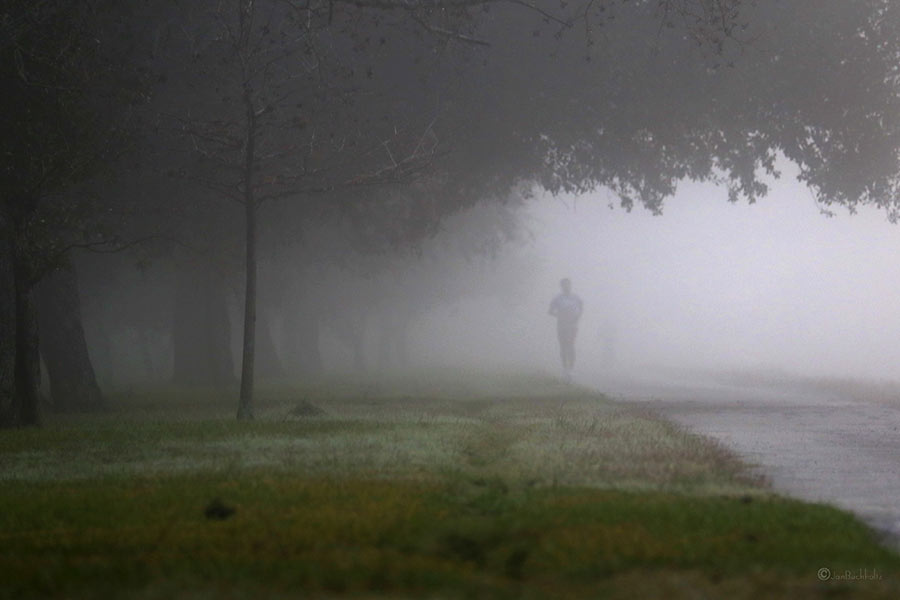 That sign posted just west of Chimney Rock declaring that the Brays Bayou trail “connects 31 miles of uninterrupted, off-street, multi-use trails and greenspace from the Ship Channel to George Bush Park and the Addicks-Barker Reservoir” is more aspirational than accurate at this point, a Houston Parks Board official admits to David Olinger. (“It got ahead of itself, let’s put it that way.”) Olinger set out to walk the supposed marathon-distance-plus continuum, but found it blocked and interrupted by construction zones, an unidentified fork to a neighboring bayou, and dead ends, including some fronting 7-miles-worth of land adjacent to Arthur Storey Park the parks board is still in the process of acquiring: “I tried walking west from Kirkwood and waded into knee-high weeds. I tried walking north on Kirkwood and found no trail. I drove up and down Kirkwood, searching in vain for Arthur Storey Park. Finally I consulted a map — and found the park about 2.5 miles northeast from the westbound Kirkwood dead end.” The Bayou Greenways trail system is expected to connect that length of Brays Bayou by 2020. [Houston Chronicle; previously on Swamplot] Photo of Brays Bayou trail: Jan Buchholtz
That sign posted just west of Chimney Rock declaring that the Brays Bayou trail “connects 31 miles of uninterrupted, off-street, multi-use trails and greenspace from the Ship Channel to George Bush Park and the Addicks-Barker Reservoir” is more aspirational than accurate at this point, a Houston Parks Board official admits to David Olinger. (“It got ahead of itself, let’s put it that way.”) Olinger set out to walk the supposed marathon-distance-plus continuum, but found it blocked and interrupted by construction zones, an unidentified fork to a neighboring bayou, and dead ends, including some fronting 7-miles-worth of land adjacent to Arthur Storey Park the parks board is still in the process of acquiring: “I tried walking west from Kirkwood and waded into knee-high weeds. I tried walking north on Kirkwood and found no trail. I drove up and down Kirkwood, searching in vain for Arthur Storey Park. Finally I consulted a map — and found the park about 2.5 miles northeast from the westbound Kirkwood dead end.” The Bayou Greenways trail system is expected to connect that length of Brays Bayou by 2020. [Houston Chronicle; previously on Swamplot] Photo of Brays Bayou trail: Jan Buchholtz
COMMENT OF THE DAY: SOME ADVICE FOR WHEN THE TRAIN ISN’T MOVING AND YOU NEED TO CROSS THE TRACKS FOR SOMETHING SUPER IMPORTANT 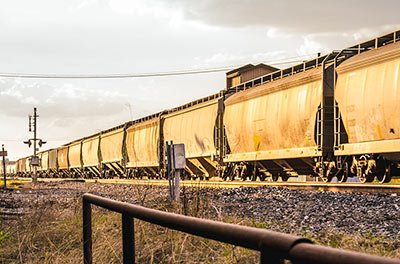 “Some ‘stalled’ train advice: 1. Never crawl under. Always climb over the coupling. 2. NEVER CLIMB OVER THE COUPLING! I was with my bike team waiting for a stopped train in this part of town. Beer was on the other side of the train, so after some time some of the cyclists started discussing crawling under or climbing over. I said not to do it, that it was too dangerous. I was assured that when the train started it would do so ever so slowly and gently. One of the cyclists started to get between the boxcars to climb over the coupling (see #1) when the train VIOLENTLY LURCHED into motion and scared the crap out of everyone. It turns out the train starts very slowly near the front, but very quickly near the end.” [Memebag, commenting on Where Lyons Ave. Will Go Down, West St. Won’t Go North, and Fifth Ward Trains Will Continue Through] Photo: Ruben Serrano, via Swamplot Flickr Pool
“Some ‘stalled’ train advice: 1. Never crawl under. Always climb over the coupling. 2. NEVER CLIMB OVER THE COUPLING! I was with my bike team waiting for a stopped train in this part of town. Beer was on the other side of the train, so after some time some of the cyclists started discussing crawling under or climbing over. I said not to do it, that it was too dangerous. I was assured that when the train started it would do so ever so slowly and gently. One of the cyclists started to get between the boxcars to climb over the coupling (see #1) when the train VIOLENTLY LURCHED into motion and scared the crap out of everyone. It turns out the train starts very slowly near the front, but very quickly near the end.” [Memebag, commenting on Where Lyons Ave. Will Go Down, West St. Won’t Go North, and Fifth Ward Trains Will Continue Through] Photo: Ruben Serrano, via Swamplot Flickr Pool
BIG I-45 DOWNTOWN REROUTING, GRAND PARKWAY EXPANSION GET GO-AHEADS 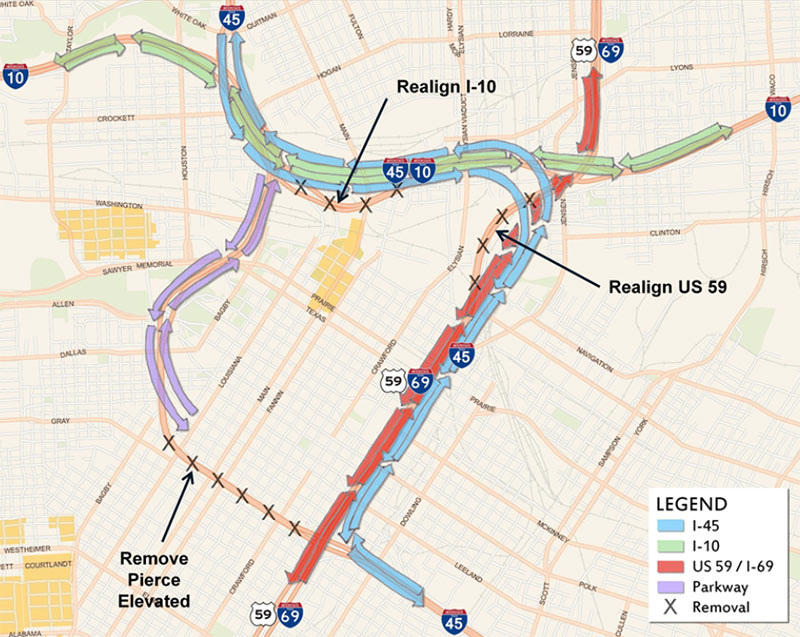 Yesterday was a big day for Houston freeway expansion and reconfiguration: On Tuesday, the Texas Transportation Commission gave the go-ahead for construction to begin in late 2020 on the first of 7 separate projects that will move I-45 from the west and south sides of Downtown to its east side, paralleling U.S. 59 behind the George R. Brown, reports Chron transportation writer Dug Begley. Separately, the commission also selected design and construction crews for the next segment of the Grand Parkway, from I-69 near New Caney to I-10 east of Baytown. How grand that section of the Grand Parkway actually ends up being may depend on your perspective: This segment of the Houston area’s fourth ring road is expected to cost $1.25 billion and open in 2022 — but the tollway will have only a single lane in each direction. [Houston Chronicle; previously on Swamplot] Diagram of I-45 rerouting: TxDOT
Yesterday was a big day for Houston freeway expansion and reconfiguration: On Tuesday, the Texas Transportation Commission gave the go-ahead for construction to begin in late 2020 on the first of 7 separate projects that will move I-45 from the west and south sides of Downtown to its east side, paralleling U.S. 59 behind the George R. Brown, reports Chron transportation writer Dug Begley. Separately, the commission also selected design and construction crews for the next segment of the Grand Parkway, from I-69 near New Caney to I-10 east of Baytown. How grand that section of the Grand Parkway actually ends up being may depend on your perspective: This segment of the Houston area’s fourth ring road is expected to cost $1.25 billion and open in 2022 — but the tollway will have only a single lane in each direction. [Houston Chronicle; previously on Swamplot] Diagram of I-45 rerouting: TxDOT
COMMENT OF THE DAY: THE NO-BIKE-LANE BIKE PLAN 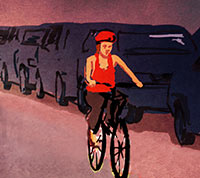 “There’s even a more simple plan: Make the right lane 12 ft. (or more) and the left lane 10 ft. Don’t stripe new bike lanes or overly alter existing regulations. Don’t plan. Don’t get approvals. Don’t p/o motorists with the silly bike lanes that bikers fear and never use. We just need a little extra space for cars to pass us by. And: Motorists will like having buses and other heavy vehicles in the larger right-lane, too . . . you don’t even need signage.” [Chris M(2)., commenting on Comment of the Day: Houston’s New Bike Plan Is Just a Plan] Illustration: Lulu
“There’s even a more simple plan: Make the right lane 12 ft. (or more) and the left lane 10 ft. Don’t stripe new bike lanes or overly alter existing regulations. Don’t plan. Don’t get approvals. Don’t p/o motorists with the silly bike lanes that bikers fear and never use. We just need a little extra space for cars to pass us by. And: Motorists will like having buses and other heavy vehicles in the larger right-lane, too . . . you don’t even need signage.” [Chris M(2)., commenting on Comment of the Day: Houston’s New Bike Plan Is Just a Plan] Illustration: Lulu
COMMENT OF THE DAY: HOUSTON’S NEW BIKE PLAN IS JUST A PLAN 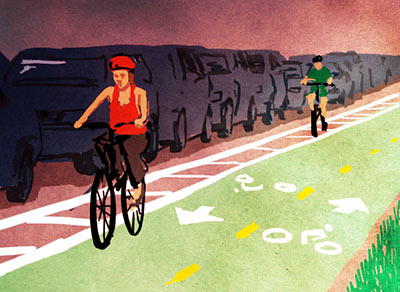 “The plan is really just a recommendation of where to put lanes. The decision of actually putting in the bike lanes in a given spot will be evaluated on a case-by-case basis, mainly as roads are rebuilt. Most of the money can come from TxDOT, TIGER, TIRZs, etc. It’s much easier to get that funding if you have a plan already in place. An example: Maybe your local CIP project involves tearing up a road and replacing it. Instead of repainting the road with the old 12-ft. wide lanes, maybe make them a reasonable 10-ft. wide and spray in a line for a bike lane. That’s a cheap addition to a project that doesn’t involve a lot of overhead that would normally come from a separate project to put in a new bike lane somewhere.” [Biker, commenting on Houston Bike Plan Up for a Vote Again This Morning Amid More California-ization Fears] Illustration: Lulu
“The plan is really just a recommendation of where to put lanes. The decision of actually putting in the bike lanes in a given spot will be evaluated on a case-by-case basis, mainly as roads are rebuilt. Most of the money can come from TxDOT, TIGER, TIRZs, etc. It’s much easier to get that funding if you have a plan already in place. An example: Maybe your local CIP project involves tearing up a road and replacing it. Instead of repainting the road with the old 12-ft. wide lanes, maybe make them a reasonable 10-ft. wide and spray in a line for a bike lane. That’s a cheap addition to a project that doesn’t involve a lot of overhead that would normally come from a separate project to put in a new bike lane somewhere.” [Biker, commenting on Houston Bike Plan Up for a Vote Again This Morning Amid More California-ization Fears] Illustration: Lulu

